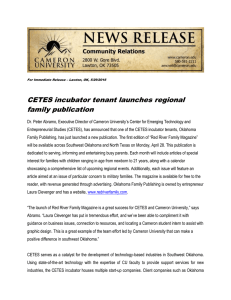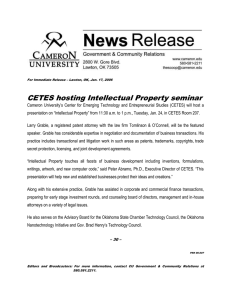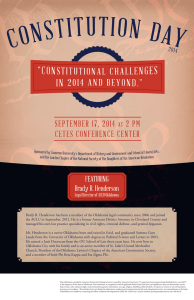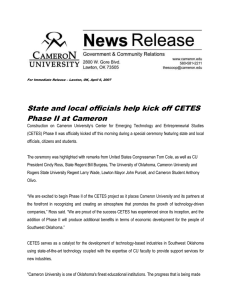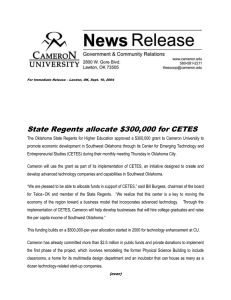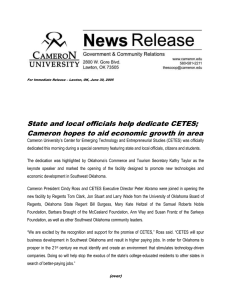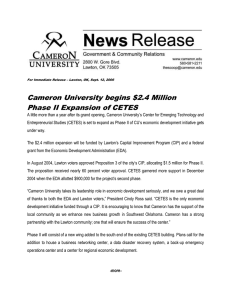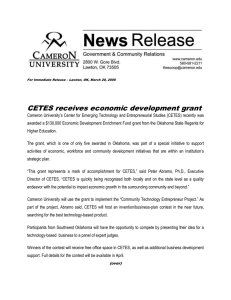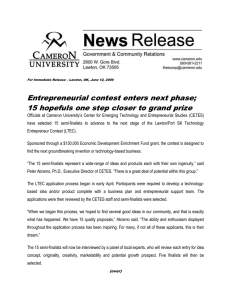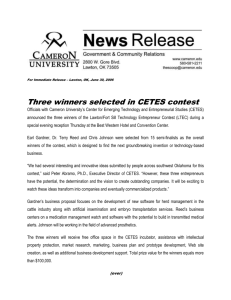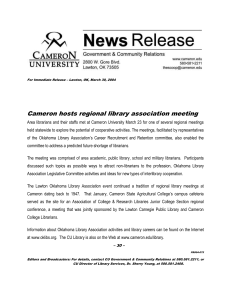Cameron begins work on new technology center
advertisement
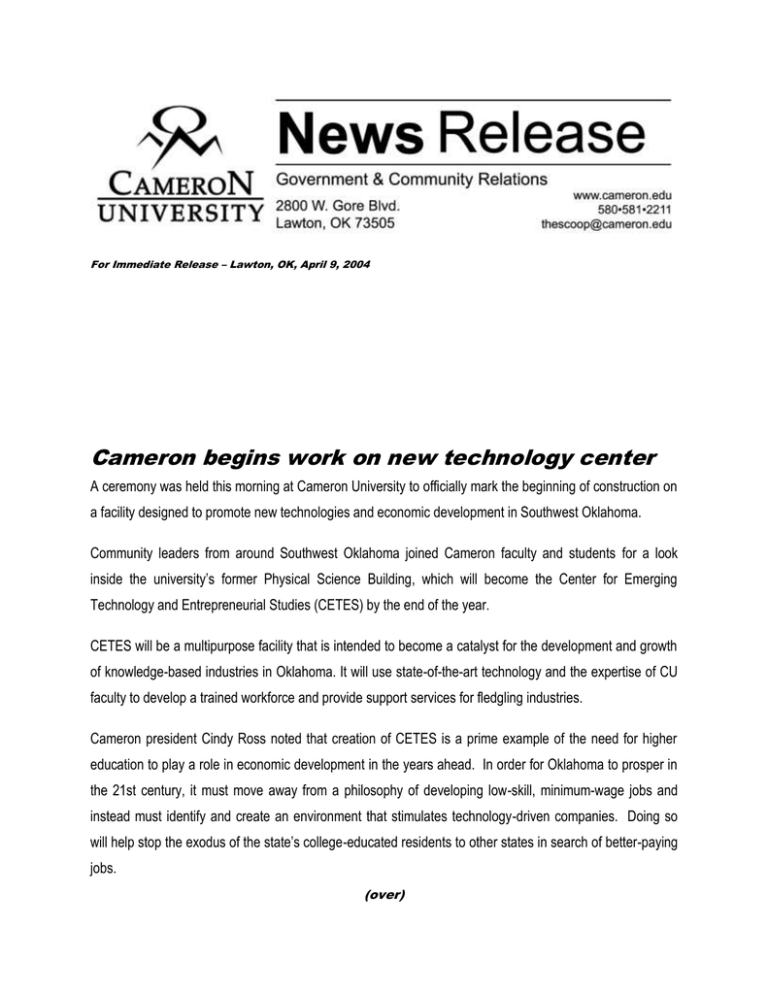
For Immediate Release – Lawton, OK, April 9, 2004 Cameron begins work on new technology center A ceremony was held this morning at Cameron University to officially mark the beginning of construction on a facility designed to promote new technologies and economic development in Southwest Oklahoma. Community leaders from around Southwest Oklahoma joined Cameron faculty and students for a look inside the university’s former Physical Science Building, which will become the Center for Emerging Technology and Entrepreneurial Studies (CETES) by the end of the year. CETES will be a multipurpose facility that is intended to become a catalyst for the development and growth of knowledge-based industries in Oklahoma. It will use state-of-the-art technology and the expertise of CU faculty to develop a trained workforce and provide support services for fledgling industries. Cameron president Cindy Ross noted that creation of CETES is a prime example of the need for higher education to play a role in economic development in the years ahead. In order for Oklahoma to prosper in the 21st century, it must move away from a philosophy of developing low-skill, minimum-wage jobs and instead must identify and create an environment that stimulates technology-driven companies. Doing so will help stop the exodus of the state’s college-educated residents to other states in search of better-paying jobs. (over) cetes, ADD ONE This philosophy strongly echoes recommendations made in a recent policy study conducted at the request of Oklahoma Gov. Brad Henry. That study, “Oklahoma’s EDGE” – which stands for Economic Development Generating Excellence – indicated that the state’s higher education institutions should become more actively involved with local business communities and establish the systems, structures and knowledge necessary to grow high-paying and high-performance companies involving new technologies. “CETES will help grow the next generation of innovators – the small young companies that will bring emerging technologies to market,” said Ross. “Cameron University will provide the necessary support network, advanced technological curriculum and business acumen for companies to become successful in our global economy.” The work now underway is the first of several phases to expand the building that housed Cameron’s physical science department from 1964 until it moved into the newly completed CU Sciences Complex in 1996. Architectural engineers inspected the Physical Science Building late last year and declared it physically sound and well suited for the proposed center. The first phase of the renovation will include space for the CU Department of MultiMedia Instructional Design. Since its creation in 1998, enrollment in this educational program has grown to three times the administration’s original projections and the department has played a key role in providing skilled employees for technology-based industries across the nation. Additionally, the department has been awarded 11 grants from the Oklahoma Center for the Advancement of Science and Technology in recent years to develop internships to strengthen knowledge-based industries. Last year, the department expanded its reputation with a grant from the U.S. Agency for International Development – as part of a consortium that included the Langston University, Oklahoma State University and the University of Oklahoma – to help rebuild Iraq’s higher education technology infrastructure. In addition to housing Cameron’s multimedia department, CETES will contain an incubator to sustain new technology companies. The center will provide office space, technical advice and computer support for entrepreneurs to encourage them to locate their businesses in Southwest Oklahoma. The center will contain as many as 12 of these units. (more) cetes, ADD TWO CETES will also become the home of the Virginia Brewczynski Endowed Chair in Management. The chair was created in 1994 by the Lawton Retail Merchants Association to advance the teaching of leadership in business. A nationwide search is currently underway to fill the position, which will also serve as assistant director of CETES. The first phase of the project will cost approximately $2.5 million. More than half that cost will be financed through private donations, including $750,000 from the Samuel Roberts Noble Foundation in Ardmore, $300,000 from the McCasland Foundation in Duncan, and $250,000 from the Sarkey’s Foundation in Tulsa. A 1998 bond issue provided nearly $1 million more, and $75,000 will come from the Governor’s Oil Overcharge Fund. The remaining cost – approximately $200,000 – will come from targeted institutional funds. Cameron administrators say that the first phase should be completed by December 2004. Additional phases planned for the development of CETES may include a large academic lecture hall, a networking center, a business conference facility and a center for regional economic development. Earlier this week, the Lawton City Council voted to include $1.5 for a multi-agency emergency operations center, data disaster recovery system and a regional emergency preparedness and recovery training center to the list of projects proposed in its 2005 Capital Improvement Program, which will be submitted to local voters later this year. – 30 – PR#04-088 Editors and Broadcasters: For more information, contact CU Government & Community Relations at 580.581.2211.
